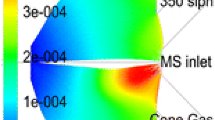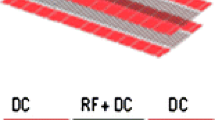Abstract
With optimized geometry and operating parameters both IMS selectivity and sensitivity can be significantly increased. However, finding these parameters and geometry requires an accurate knowledge of the electrical field and the ion concentration within the IMS at any time of operation. Furthermore, the ion loss at metallic surfaces and space charge effects caused by the moving ion cloud must be considered. This is particularly true when using non-radioactive electron emitters which generate a comparably high space charge density at electron currents similar to radioactive beta-sources due to their smaller ionization volume. This can lead to a reduced IMS resolution mainly caused by coulomb repulsion. In this work a transient model which enables a detailed view on the electric field within the IMS considering ion diffusion and migration as well as ion loss and coulomb repulsion is presented. This finite element model provides excellent agreement between simulated IMS spectra and experimental data especially when considering space charge effects and coulomb repulsion respectively. The model is used to design a short drift tube IMS with significantly improved resolution. Furthermore, this model allows considering ion-ion and ion-neutral reactions, such as ion generation, charge transfer reactions and ion-ion recombination. Moreover, fluid dynamics can be considered as required for modeling aspiration type IMS.













Similar content being viewed by others
References
Eiceman GA, Karpas Z (2005) Ion mobility spectrometry. CRC Press
Borsdorf H, Eiceman GA (2006) Ion mobility spectrometry: Principles and applications. Appl Spectroscopy Rev 41:323–375
Borsdorf H, Mayer T, Zarejousheghani M, Eiceman GA (2011) Recent developments in ion mobility spectrometry. Appl Spectroscopy Rev 46:472–521
Kanu AB, Gribb MM, Hill HH Jr (2008) Predicting optimal resolving power for ambient pressure ion mobility spectrometry. Anal Chem 80:6610–6619
Puton J, Knap A, Siodlowski B (2008) Modelling of penetration of ions through a shutter grid in ion mobility spectrometers. Sensors and Actuators B 135:116–121
Tolmachev AV, Clowers BH, Belov ME, Smith RD (2009) Coulombic effects in ion mobility spectrometry. Anal Chem 15;81(12):4778–4787
Xu J, Whitten WB, Ramsey JM (2000) Space charge effects on resolution in a miniature ion mobility spectrometer. Anal Chem 72:5787–5791
Gunzer F, Ulrich A, Baether W (2010) A novel non-radioactive electron source for ion mobility spectrometry. Int J Ion Mobil Spec 13:9–16
Cochems P, Gunzer F, Langejuergen J, Heptner A, Zimmermann S (2011) Selective ion suppression as a pre-separation method in ion mobility spectrometry using a pulsed electron gun. Int J Ion Mobil Spec 15:31–39
Gunzer F, Zimmermann S, Baether W (2010) Application of a non-radioactive pulsed electron source for ion mobility spectrometry. Anal Chem 82:3756–3763
Morozov A, Krücken R, Ulrich A (2006) Spatial distribution of fluorescent light emitted from neon and nitrogen excited by low energy electron beams. J Appl Physics 100:093305
Morozov A, Heindl T, Skrobol C, Wieser J, Krücken R, Ulrich A (2008) Transmission of 10 keV electron beams through thin ceramic foils: Measurements and Monte Carlo simulations of electron energy distribution functions. Eur Phys J D 48:383–388
Cumeras R et al (2010) Finite-element analysis of a miniaturized ion mobility spectrometer for security applications, Sens. Actuators B: Chem
Author information
Authors and Affiliations
Corresponding author
Additional information
Presented in parts at the ISIMS conference, July, 2011
Rights and permissions
About this article
Cite this article
Langejuergen, J., Cochems, P. & Zimmermann, S. Results of a transient simulation of a drift tube ion mobility spectrometer considering charge repulsion, ion loss at metallic surfaces and ion generation. Int. J. Ion Mobil. Spec. 15, 247–255 (2012). https://doi.org/10.1007/s12127-012-0095-z
Received:
Revised:
Accepted:
Published:
Issue Date:
DOI: https://doi.org/10.1007/s12127-012-0095-z




